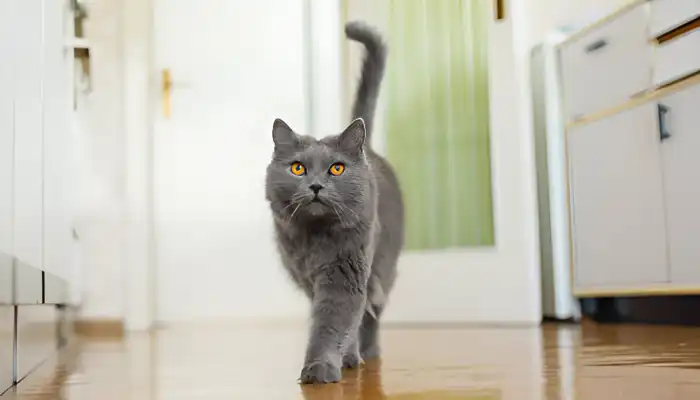How do cats say “good bye”? Ever wondered how your feline friend says goodbye? You’re not the only one! Instead of verbally saying the words, cats possess their own unique methods of communication. To show emotions such as the time to say goodbye, cats rely on body language, tail movements, and even vocalizations.
From slow blinking to purring and seeking solitude, these subtle signals tell you everything you need to know about how your feline friend is bidding farewell. Let’s dive into the world of cat-translator communication and uncover the behaviors that indicate it’s time for them to say goodbye

What Does “Good Bye” Mean for Cats?
To start with, how do cats say “good bye”? Cats do not bid adieu or ‘goodbye’ with a verbal cue like people do. Instead, cats use body language and slight movements to communicate with humans. A cat conveys mood through subtle signals that are gentle yet forceful.
- Words are out of the question for cats; just like how cats don’t use speech to express themselves, there are actions, movements, and sounds that cats use to express emotions.
- To part ways with a cat, you must take care of vocalizations (purring or meowing), body language (eye contact and tail movements), and, from time to time, behavioral changes (solitude seeking).
Now you can understand when your feline friend wants to bid farewell by interpreting the signals he/she give.
Common Behaviors Cats Show When Leaving
The answer to how do cats say “good bye”? lies in their body language expressions. Cats have some elaborate ways to help you understand when it is time to bid farewell. Take a look at some of the most common signs that cats show to help you understand that it is time to leave.
Movements of the Tail
Felines are very vocal, and their tail is one of the ways they communicate. Cats use their tails to express a wide range of emotions, including when they are about to bid farewell.
- Swishing or Flicking: If a cat wishes to indicate that they are departing or are attempting to say goodbye, they will slowly start to swish or flick their tail. Such movements generally suggest that the cat is deep in thought or ready to proceed.
- Upright Tail: If your feline friend is showing off his tail and slightly quaking it, they may say their goodbyes or are in the mood to cuddle with you.
Eye Contact and Blinking
A cat’s feelings can also be expressed through eye contact. They will use their eyes to express love and trust to others.
- Slow Blinking: One of the easiest techniques pets use to say goodbye is slow blinking. A relaxed pet who is feeling comfy may fold halfway as they feel happy.
- Avoiding Eye Contact: Some cats may evade eye contact and do not want to socially interact anymore.
Vocalizations
Some cats tend to be more vocal than others, but during a goodbye, most find it useful to speak via purrs and meows.
- Short Meows: When you hear your feline taking off with a gentle meow, it may be hinting it’s off. It tends to say “Goodbye for now” or “I’ll come back.”.
- Purring: Purring normally means they attain happiness, but can also double as a way to comfort themselves. They will often purr towards the end of an interaction as a sign of self-soothing.
Seeking Solitude
Other cats do like a quiet place to be alone to say goodbye. Cats tend to retreat to a quiet spot or snuggle in a favorite cozy corner, which means that they are ready to go.
If you’re interested in How Do Cats Say “Good Bye”?, you’re in the right place. The answer lies in the connection you have with your feline companion. Cats who are attached to their human guardians tend to have specific ways of saying goodbye.
Can Cats Grasp What Goodbye Means?
Cats have highly sensitive sensors and can feel where they are and how things alter around them. With how do cats say “good bye”?, one of the many factors is how well they can understand and respond to the situation.
- Routine Awareness: Cats notice tiny things, and as such, any routine change is likely to be picked. For instance, if you are used to leaving the house at a particular time, your cat is likely to be waiting for you around that time and start to behave differently.
- Emotional Sensitivity: A cat can feel the race of their owner. Therefore, the moment you walk out of your house carrying a sad or anxious feeling, your cat is likely to have those feelings as well. The same goes for cat farewell behavior; it is part of the emotional response they have.
How Do Cats Say Goodbye To Their Owners?
- Following You To The Door: How some cats express their affection for their owners is by following them to the door when it’s time to go out. It is another way of saying, “I will miss you.” Or, “Safe travels, and hurry on back.”
- Sitting By The Door Or Window: Perched on a windowsill or sitting on the floor waiting close to the door is another way cats demonstrate emotional bonds. After you leave, your cat may put themselves in that position as a way to emotionally remember you while watching you go.
- Purring at Your Feet: At times, cats will approach you and start purring as if to communicate it is time to part ways. The cat’s purr has a therapeutic effect on them, which also shows how much they care.
Similar to humans, cats can easily identify changes in their environment as well as one’s feelings. Notably, the way they say “Goodbye” is greatly impacted by their interpretation of these aspects.
How to Interpret Your Cat’s Farewell Behavior
Do you want to understand what your cat means when they say “goodbye”? Here we tell you how you can improve your relationship with your cat by understanding their farewell gestures.
- Study Their Body Language: Make sure to focus on your cat’s ears, their tail, as well as their eyes. You can tell how they are feeling by looking for these telltale signs.
- Stick to a Schedule: Cats prefer and perform much better when they work with a schedule. If leaving and returning home is a routine for you, then it’s best to keep sticking to that schedule as your cat learns when to expect your return.
- Help Them When They Need You: If your cat looks like they want to be left alone, then give your cat time alone. But if they seem to look for comfort, then give them your full attention.
| Signal | What It Means | Action to Take |
|---|---|---|
| Tail Flicking | Sign of departure or contemplation. | Acknowledge with a gentle pet. |
| Slow Blinking | Sign of trust and affection. | Blink back slowly to communicate affection. |
| Meowing | Sign of communication or request. | Respond gently or pet your cat. |
| Seeking Solitude | Time for personal space or goodbye. | Allow your cat to retreat quietly. |
Understanding your cat’s farewell gestures strengthens your bond and helps improve communication. By paying attention to their body language, maintaining routines, and offering comfort when needed, you can enhance your relationship with your feline companion.
Conclusion
How do cats say “good bye”? Understanding a cat’s departure signals can strengthen your bond with your feline friend. Cats communicate their goodbyes through subtle body language, such as tail flicking, slow blinking, or seeking solitude.
Whether they follow you to the door, perch by the window, or give a gentle purr, each behavior holds meaning. By paying close attention to these cues, you can better understand your cat’s emotional responses and deepen your connection, ensuring a loving, respectful farewell every time.
